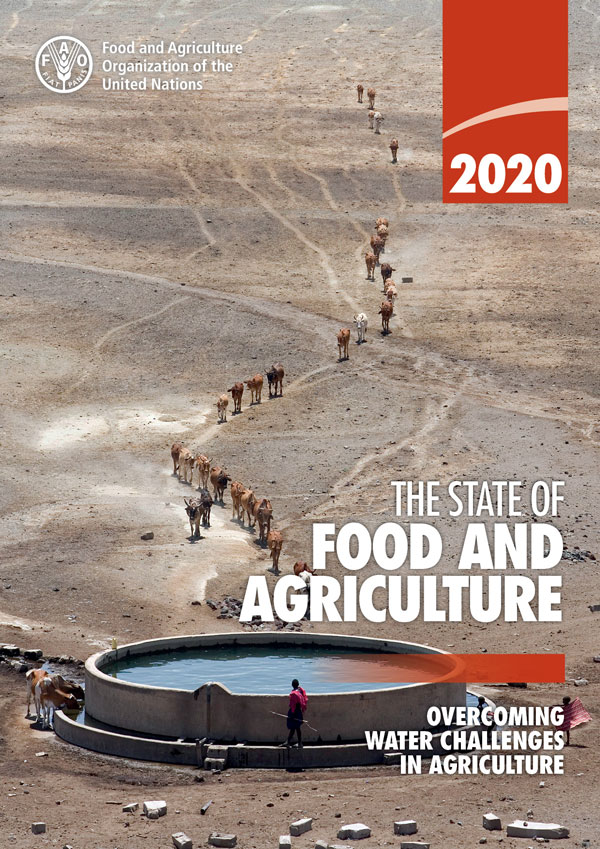Agriculture is the world’s largest water user, accounting for more than 70 percent of
global withdrawals.
Solutions
Achieving efficient, equitable and sustainable water use in
agriculture
Many measures exist that can make water use more sustainable in different contexts around the world.
Awareness is key - Transparent water accounting and auditing
The type of measures needed will depend on the extent of the water constraints in a watershed. Water
accounting and auditing, which are rarely done, should be the basis for any effective strategy for
addressing water shortages and scarcity, especially in agriculture. Together, accounting and auditing
can provide the basis for more realistic, sustainable, effective and equitable water management. FAO’s
recent sourcebook provides a good starting point for all those wishing to implement water accounting and
auditing.
Water accounting and auditing should be the basis for any effective strategy for
addressing water shortages and scarcity, especially in agriculture.
Making better use of rainwater in rainfed areas
Producers – many of them small-scale farmers – working on 128 million hectares (or 11 percent) of rainfed
cropland affected by recurring drought can greatly benefit from water water-harvesting and water
conservation techniques. By one estimate, these practices could boost rainfed kilocalorie
production by up to 24 percent and, if combined with irrigation expansion, by more than 40 percent.
Producers – many of them small-scale farmers – working on rainfed cropland affected by
recurring drought can greatly benefit from water-harvesting and water conservation techniques.
For herders working on 656 million hectares (or 14 percent) of drought-affected pastureland, a variety of
farming measures can buffer the impact of drought and improve water productivity. Many of these measures
are indirectly related to water, including disease control and animal health, livestock feeding and
drinking management, mobility and stratification of production to reduce grazing pressure in
arid areas.
Investing in sustainable irrigation for improved water
productivity
For the 171 million hectares (or 62 percent) of the world’s irrigated cropland under high or very high
water stress, priority should be given to incentivizing practices that increase water productivity –
including rehabilitation and modernization of existing irrigation infrastructure and adoption of
innovative technologies. These should be combined with improved water governance to guarantee equitable
allocation and access to water, as well as environmental flows necessary to sustain water-related
ecosystems. In sub-Saharan Africa, irrigated areas are expected to more than double by 2050, benefiting
millions of small-scale farmers.
Improved water governance can guarantee equitable allocation and access to water.
Non-consumptive uses and non-conventional sources of water
Investing in non-consumptive uses of water – for instance in aquaculture – and in non-conventional
sources of water, such as water reuse and desalination, is an increasingly important strategy to offset
scarcity; however innovations must be economically efficient, socially acceptable, environmentally
sustainable and appropriate to the context.
An increasingly important strategy to offset water scarcity is investing in
non-consumptive uses of water like aquaponics.
Guaranteeing environmental flow requirements
Improving sustainability of water use in agriculture will also mean guaranteeing environmental flow
requirements to sustain ecosystem functions, which are often overlooked.
It has been estimated that 41 percent of current global irrigation water use occurs at the expense of
environmental flow requirements.
It is necessary to reduce water withdrawals and improve water-use efficiency in watersheds where
environmental flow requirements are not guaranteed. This must be based on transparent water accounting
and auditing.
Policies that foster innovation
The above solutions need to be adopted more widely to ensure sustainable water use. Policies and
regulations play a central role in boosting the implementation of technologies and innovations, for
example, through financing, capacity-development programmes and enforcing environmental flow
requirements.
Policies and regulations play a central role in boosting the implementation of
technologies and innovations
But they require appropriate allocation of water rights and secure water tenure to enable secure,
equitable and sustainable access to water, especially for the most vulnerable, while ensuring
environmental flow requirements.
Policy coherence and governance mechanisms across sectors are essential for efficient, sustainable and
equitable water resources management. In agriculture, specifically, coherent and inclusive strategies
are needed across rainfed and irrigated cropland, livestock production systems, inland fisheries,
aquaculture and forestry.
Want to find out more?
There is no “one-size-fits-all” approach to addressing water shortages and scarcity. Different countries
– and even different regions within countries – have different characteristics and face different
challenges.
The State of Food and Agriculture: Overcoming water challenges in agriculture offers appropriate options for addressing water-related challenges in order to improve food security and nutrition and ensure environmental sustainability in the spirit of the 2030 Agenda.

READ THE FULL REPORT

